Sustainable Surface Water Storage Development: Measuring Economic Benefits and Ecological and Social Impacts of Reservoir System Configurations
Abstract
:1. Introduction
2. Methodology
2.1. Measuring Economic Benefits
2.2. Measuring Ecological Impacts
2.2.1. Environmental Flow Yield
2.2.2. Flow Regulation
- (a)
- Overcome the nonavailability of river volumes (or even river depths and widths) for all river segments of the case study basins and introduce an alternative parameter to weight the individual DOR by each reservoir;
- (b)
- Develop a metric that captures differences between having centralized versus distributed reservoirs in a river network;
- (c)
- Formulate an index capable of demonstrating the differences between reservoirs located in upstream reaches and main stems of rivers.
2.2.3. River Connectivity
2.3. Measuring Social Impacts
2.4. Comparison of Reservoir System Configurations
3. Example Case Studies
3.1. Example Case Study Basins
3.2. Data and Reservoir System Configuration Scenarios
4. Results and Discussion
4.1. WS Yield and EF Yield
4.2. Flow Regulation
4.3. River Connectivity
4.4. Normalized Externality
4.5. Comparison of Reservoir System Configurations
5. Conclusions
Author Contributions
Funding
Institutional Review Board Statement
Informed Consent Statement
Data Availability Statement
Acknowledgments
Conflicts of Interest
References
- International Commission on Large Dams. 2020. Available online: https://www.icold-cigb.org/GB/world_register/general_synthesis.asp (accessed on 8 April 2020).
- United Nations Economic and Social Commission for Asia and the Pacific (UN ESCAP). Enhancing Regional Cooperation in Infrastructure Development Including that Related to Disaster Management; United Nations: New York, NY, USA, 2006. [Google Scholar] [CrossRef]
- Hanasaki, N.; Yoshikawa, S.; Pokhrel, Y.; Kanae, S. A global hydrological simulation to specify the sources of water used by humans. Hydrol. Earth Syst. Sci. 2018, 22, 789–817. [Google Scholar] [CrossRef] [Green Version]
- International Energy Agency (IEA). Key World Energy Statistics; International Energy Agency: Paris, France, 2018. [Google Scholar]
- International Hydropower Association (IHA). 2018 Hydropower Status Report; International Hydropower Association: London, UK, 2018. [Google Scholar]
- Zarfl, C.; Lumsdon, A.E.; Berlekamp, J.; Tydecks, L.; Tockner, K. A global boom in hydropower dam construction. Aquat. Sci. 2014, 77, 161–170. [Google Scholar] [CrossRef]
- Liu, L.; Parkinson, S.; Gidden, M.; Byers, E.; Satoh, Y.; Riahi, K.; Forman, B. Quantifying the potential for reservoirs to secure future surface water yields in the world’s largest river basins. Environ. Res. Lett. 2018, 13, 44026. [Google Scholar] [CrossRef]
- Perera, D.; Smakhtin, V.; Williams, S.; North, T.; Curry, A. Ageing Water Storage Infrastructure: An Emerging Global Risk. UNU-INWEH Rep. Ser. 2021, 11, 7–8. [Google Scholar]
- Poff, N.L.R.; Olden, J.D. Can dams be designed for sustainability? Science 2017, 358, 1252–1253. [Google Scholar] [CrossRef] [PubMed]
- Anderson, E.P.; Jenkins, C.N.; Heilpern, S.; Maldonado-Ocampo, J.A.; Carvajal-Vallejos, F.M.; Encalada, A.C.; Rivadeneira, J.F.; Hidalgo, M.; Cañas, C.M.; Ortega, H.; et al. Fragmentation of Andes-to-Amazon connectivity by hydropower dams. Sci. Adv. 2018, 4, eaao1642. [Google Scholar] [CrossRef] [Green Version]
- Grill, G.; Lehner, B.; Thieme, M.; Geenen, B.; Tickner, D.; Antonelli, F.; Babu, S.; Borrelli, P.; Cheng, L.; Crochetiere, H.; et al. Mapping the world’s free-flowing rivers. Nature 2019, 569, 215–221. [Google Scholar] [CrossRef]
- Van Puijenbroek, P.J.T.M.; Buijse, A.D.; Kraak, M.H.S.; Verdonschot, P.F.M. Species and river specific effects of river fragmentation on European anadromous fish species. River Res. Appl. 2019, 35, 68–77. [Google Scholar] [CrossRef]
- van der Zaag, P.; Gupta, J. Scale issues in the governance of water storage projects. Water Resour. Res. 2008, 44, W10417. [Google Scholar] [CrossRef] [Green Version]
- Scudder, T. Development-Induced Community Resettlement 1. In New Directions in Social Impact Assessment; Vanclay, F., Esteves, A.M., Eds.; Edward Elgar Publishing: Cheltenham, UK, 2011. [Google Scholar] [CrossRef]
- Beck, M.W.; Claassen, A.H.; Hundt, P.J. Environmental and livelihood impacts of dams: Common lessons across development gradients that challenge sustainability. Int. J. River Basin Manag. 2012, 10, 73–92. [Google Scholar] [CrossRef]
- Soukhaphon, A.; Baird, I.G.; Hogan, Z.S. The Impacts of Hydropower Dams in the Mekong River Basin: A Review. Water 2021, 13, 265. [Google Scholar] [CrossRef]
- Shah, E.; Boelens, R.; Bruins, B. Reflections: Contested Epistemologies on Large Dams and Mega-Hydraulic Development. Water 2019, 11, 417. [Google Scholar] [CrossRef] [Green Version]
- Vij, S.; Warner, J.; Barua, A. Power in water diplomacy. Water Int. 2020, 45, 249–253. [Google Scholar] [CrossRef]
- Grill, G.; Dallaire, C.O.; Chouinard, E.F.; Sindorf, N.; Lehner, B. Development of new indicators to evaluate river fragmentation and flow regulation at large scales: A case study for the Mekong River Basin. Ecol. Indic. 2014, 45, 148–159. [Google Scholar] [CrossRef]
- Eriyagama, N.; Smakhtin, V.; Udamulla, L. Sustainable Surface Water Storage Development Pathways and Acceptable Limits for River Basins. Water 2021, 13, 645. [Google Scholar] [CrossRef]
- González-Zeas, D.; Garrote, L.; Iglesias, A. Assessing maximum potential water withdrawal for food production under climate change-An application in Spain. J. Water Clim. Chang. 2014, 5, 633–651. [Google Scholar] [CrossRef]
- Porse, E.C.; Sandoval-Solis, S.; Lane, B.A. Integrating Environmental Flows into Multi-Objective Reservoir Management for a Transboundary, Water-Scarce River Basin: Rio Grande/Bravo. Water Resour. Manag. 2015, 29, 2471–2484. [Google Scholar] [CrossRef]
- Rheinheimer, D.E.; Liu, P.; Guo, S. Re-operating the Three Gorges Reservoir for Environmental Flows: A Preliminary Assessment of Trade-offs. River Res. Appl. 2015, 32, 257–266. [Google Scholar] [CrossRef]
- Chen, M.; Dong, Z.; Jia, W.; Ni, X.; Yao, H. Multi-Objective Joint Optimal Operation of Reservoir System and Analysis of Objectives Competition Mechanism: A Case Study in the Upper Reach of the Yangtze River. Water 2019, 11, 2542. [Google Scholar] [CrossRef] [Green Version]
- Jiang, Z.; Liu, P.; Ji, C.; Zhang, H.; Chen, Y. Ecological flow considered multi-objective storage energy operation chart optimization of large-scale mixed reservoirs. J. Hydrol. 2019, 577, 123949. [Google Scholar] [CrossRef]
- Wang, Y.; Liu, P.; Dou, M.; Li, H.; Ming, B.; Gong, Y.; Yang, Z. Reservoir ecological operation considering outflow variations across different time scales. Ecol. Indic. 2021, 125, 107582. [Google Scholar] [CrossRef]
- Jager, H.; Efroymson, R.; Opperman, J.J.; Kelly, M.R. Spatial design principles for sustainable hydropower development in river basins. Renew. Sustain. Energy Rev. 2015, 45, 808–816. [Google Scholar] [CrossRef] [Green Version]
- Roozbahani, R.; Abbasi, B.; Schreider, S.; Hosseinifard, Z. A basin-wide approach for water allocation and dams location-allocation. Ann. Oper. Res. 2019, 287, 323–349. [Google Scholar] [CrossRef]
- Eriyagama, N.; Smakhtin, V.; Udamulla, L. How much artificial surface storage is acceptable in a river basin and where should it be located: A review. Earth-Sci. Rev. 2020, 208, 103294. [Google Scholar] [CrossRef]
- Vogel, R.M.; Sieber, J.; Archfield, S.A.; Smith, M.P.; Apse, C.D.; Huber-Lee, A. Relations among storage, yield, and instream flow. Water Resour. Res. 2007, 43, W05403. [Google Scholar] [CrossRef]
- Thomas, H.A., Jr.; Burden, R.P. Operations Research in Water Quality Management; Harvard University: Cambridge, MA, USA, 1963. [Google Scholar]
- Rippl, W. The capacity of storage-reservoirs for water supply. Minutes Proc. Instit. Civ. Eng. 1883, 71, 270–278. [Google Scholar]
- Lehner, B.; Liermann, C.R.; Revenga, C.; Vorosmarty, C.; Fekete, B.; Crouzet, P.; Döll, P.; Endejan, M.; Frenken, K.; Magome, J.; et al. High-resolution mapping of the world’s reservoirs and dams for sustainable river-flow management. Front. Ecol. Environ. 2011, 9, 494–502. [Google Scholar] [CrossRef] [Green Version]
- Dynesius, M.; Nilsson, C. Fragmentation and Flow Regulation of River Systems in the Northern Third of the World. Science 1994, 266, 753–762. [Google Scholar] [CrossRef]
- Nilsson, C.; Reidy, C.A.; Dynesius, M.; Revenga, C. Fragmentation and Flow Regulation of the World’s Large River Systems. Science 2005, 308, 405–408. [Google Scholar] [CrossRef] [Green Version]
- Ward, J.V. The four-dimensional nature of lotic ecosystems. J. N. Am. Benthol. Soc. 1989, 8, 2–8. [Google Scholar] [CrossRef]
- Pringle, C. What is hydrologic connectivity and why is it ecologically important? Hydrol. Process. 2003, 17, 2685–2689. [Google Scholar] [CrossRef]
- Rodriguez-Iturbe, I.; Muneepeerakul, R.; Bertuzzo, E.; Levin, S.; Rinaldo, A. River networks as ecological corridors: A complex systems perspective for integrating hydrologic, geomorphologic, and ecologic dynamics. Water Resour. Res. 2009, 45, W01413. [Google Scholar] [CrossRef]
- Harvey, J.; Gomez-Velez, J.; Schmadel, N.; Scott, D.; Boyer, E.; Alexander, R.; Eng, K.; Golden, H.; Kettner, A.; Konrad, C.; et al. How Hydrologic Connectivity Regulates Water Quality in River Corridors. JAWRA J. Am. Water Resour. Assoc. 2019, 55, 369–381. [Google Scholar] [CrossRef]
- Perkin, J.S.; Gido, K.B. Fragmentation alters stream fish community structure in dendritic ecological networks. Ecol. Appl. 2012, 22, 2176–2187. [Google Scholar] [CrossRef] [PubMed]
- Mahlum, S.; Kehler, D.; Cote, D.; Wiersma, Y.F.; Stanfield, L. Assessing the biological relevance of aquatic connectivity to stream fish communities. Can. J. Fish. Aquat. Sci. 2014, 71, 1852–1863. [Google Scholar] [CrossRef]
- Vörösmarty, C.J.; McIntyre, P.B.; Gessner, M.O.; Dudgeon, D.; Prusevich, A.; Green, P.; Glidden, S.; Bunn, S.E.; Sullivan, C.A.; Liermann, C.R.; et al. Global threats to human water security and river biodiversity. Nature 2010, 467, 555–561. [Google Scholar] [CrossRef] [PubMed]
- Lassalle, G.; Crouzet, P.; Rochard, E. Modelling the current distribution of European diadromous fishes: An approach integrating regional anthropogenic pressures. Freshw. Biol. 2009, 54, 587–606. [Google Scholar] [CrossRef]
- Cote, D.; Kehler, D.G.; Bourne, C.; Wiersma, Y. A new measure of longitudinal connectivity for stream networks. Landsc. Ecol. 2009, 24, 101–113. [Google Scholar] [CrossRef] [Green Version]
- Larson, S. Index-based tool for preliminary ranking of social and environmental impacts of hydropower and storage reservoirs. Energy 2007, 32, 943–947. [Google Scholar] [CrossRef]
- Habibi Davijani, M.; Banihabib, M.E.; Nadjafzadeh Anvar, A.; Hashemi, S.R. Multi-Objective Optimization Model for the Allocation of Water Resources in Arid Regions Based on the Maximization of Socioeconomic Efficiency. Water Resour. Manag. 2016, 30, 927–946. [Google Scholar] [CrossRef]
- Panabokke, C.R.; Sakthivadivel, R.; Weerasinghe, A.D. Evolution, Present Status and Issues Concerning Small Tank Systems in Sri Lanka; International Water Management Institute (IWMI): Colombo, Sri Lanka, 2002. [Google Scholar]
- Meegastenna, T.J. Asessment of Climate Change Impacts and Adaptation Measures to Malwatu Oyamalwatu Oya River Basin in North Central Province of Sri Lanka. In Proceedings of the International Workshop on Developing the Strategy for Impact Assessment of and Adaptation to the Climate Change as the “New Normal”, 3rd World Irrigation Forum, Bali, Indonesia, 1–7 September 2019. [Google Scholar]
- Nandalal, H.K.; Ratnayake, U.R. Setting up of Indices to Measure Vulnerability of Structures during a Flood. In Proceedings of the International Conference on Sustainable Built Environment (ICSBE-2010), Kandy, Sri Lanka, 13–14 December 2010; Available online: https://core.ac.uk/download/pdf/141733401.pdf (accessed on 22 February 2021).
- Atukorala, A.K.D.N. Diversion of Gin and Nilwala Rivers for Augmentation of Southeast Dry Zone in Sri Lanka. In Proceedings of the 32nd WEDC International Conference, Colombo, Sri Lanka, 13–17 September 2006. [Google Scholar]
- Purasinghe, S.N. Morphometric Analysis of Malwathu Oya and Kalu Ganga River Basins. Bachelor’s Thesis, General Sir John Kotelawala Defense University, Colombo, Sri Lanka, 2019. [Google Scholar]
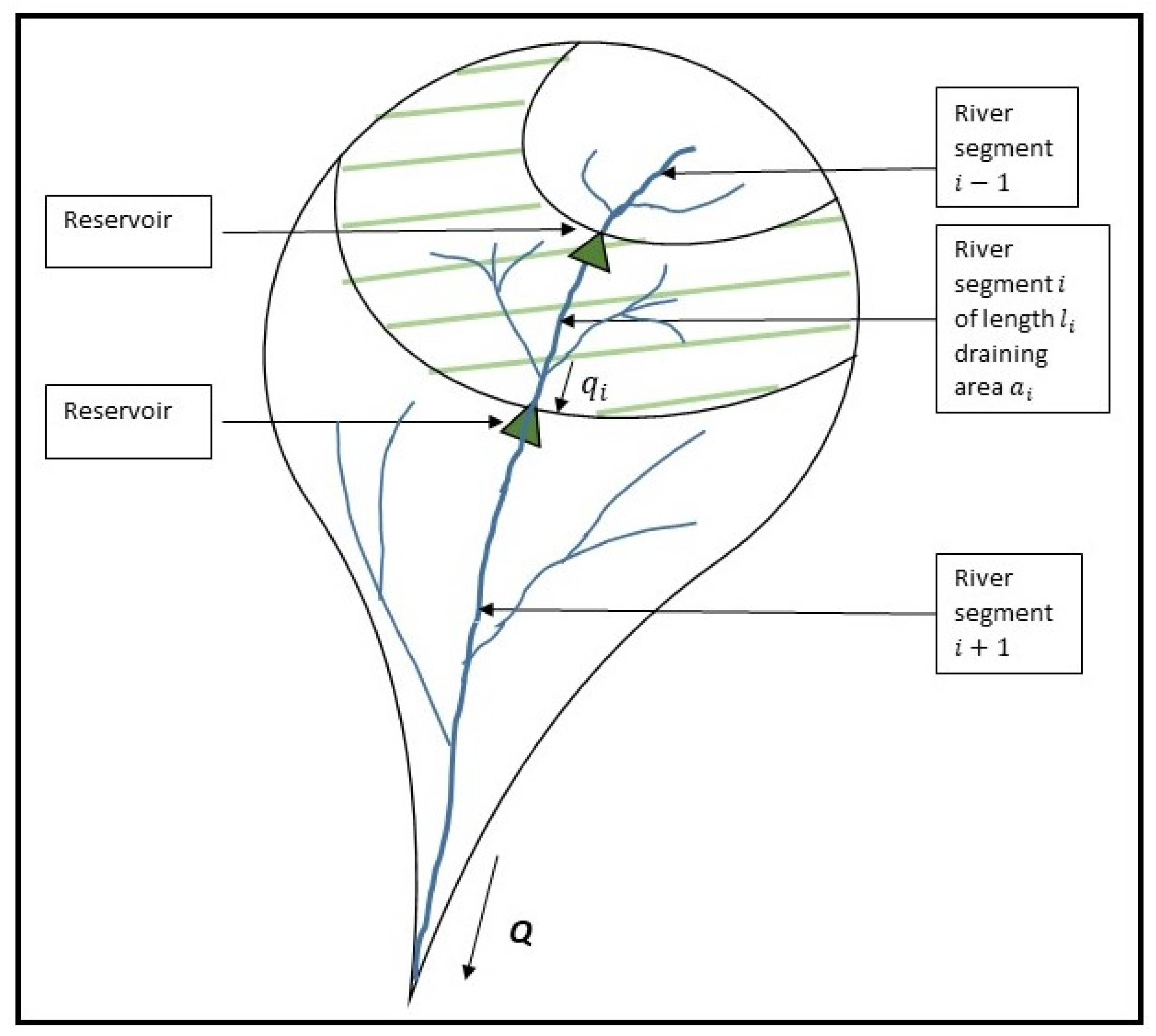
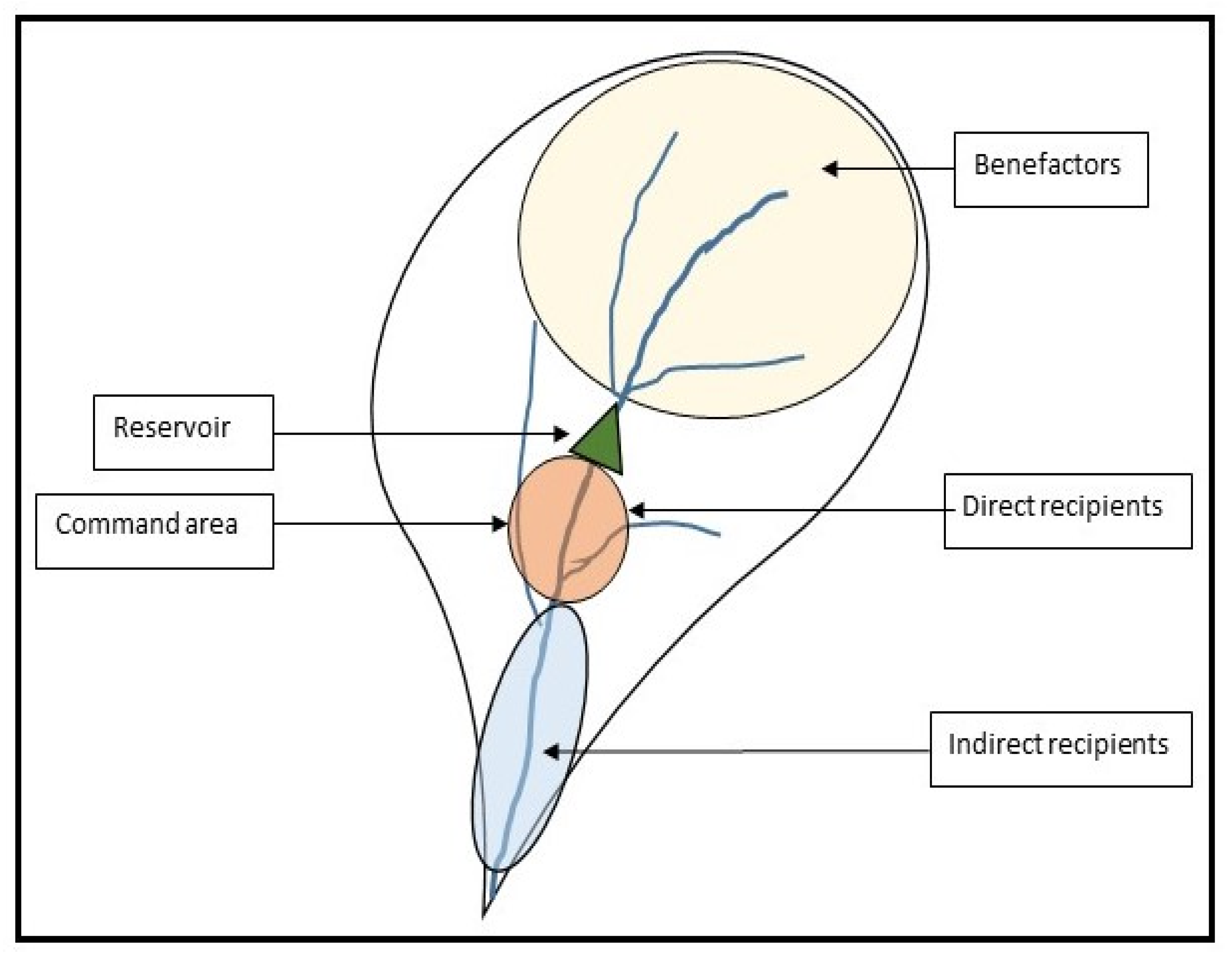
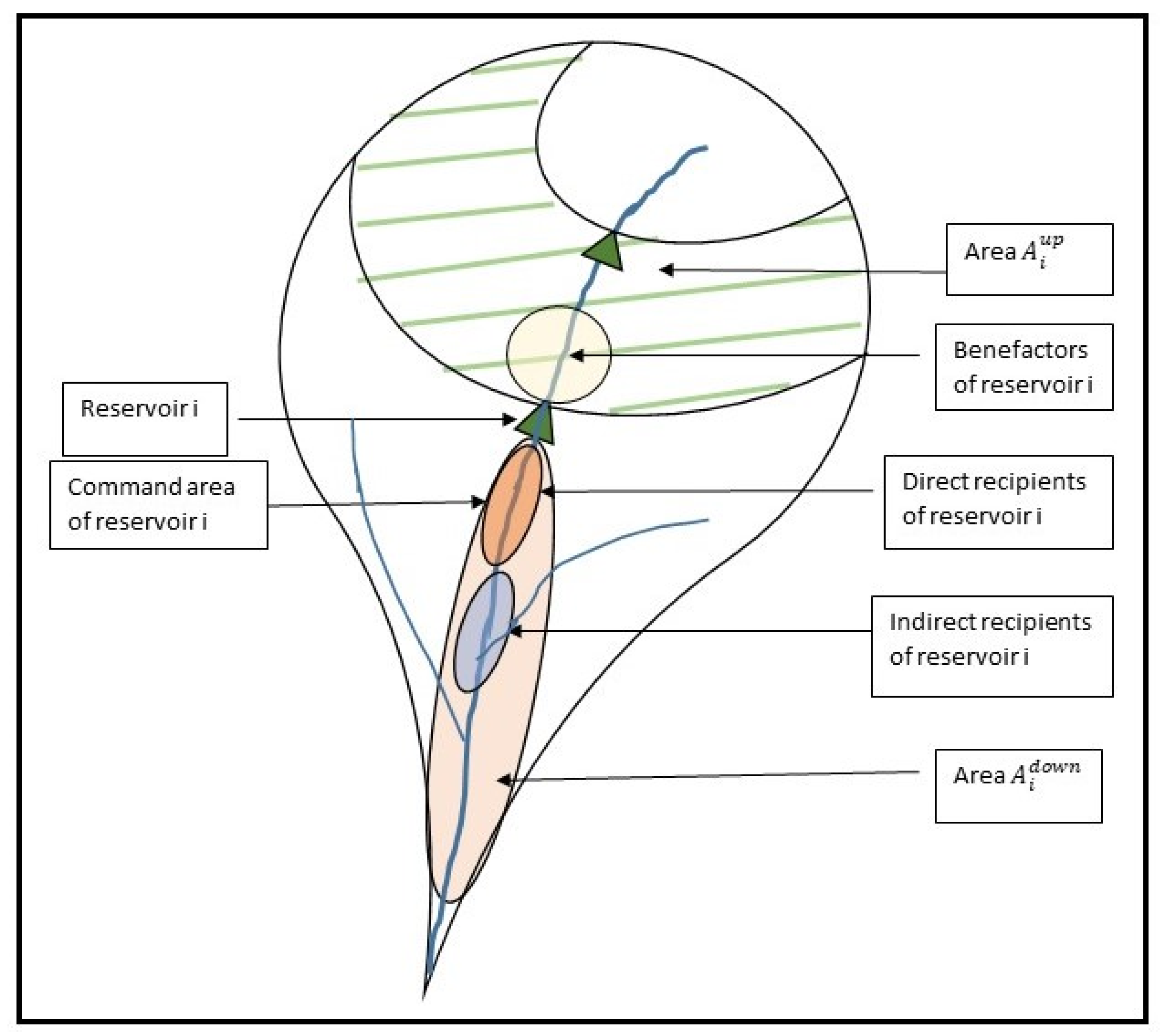

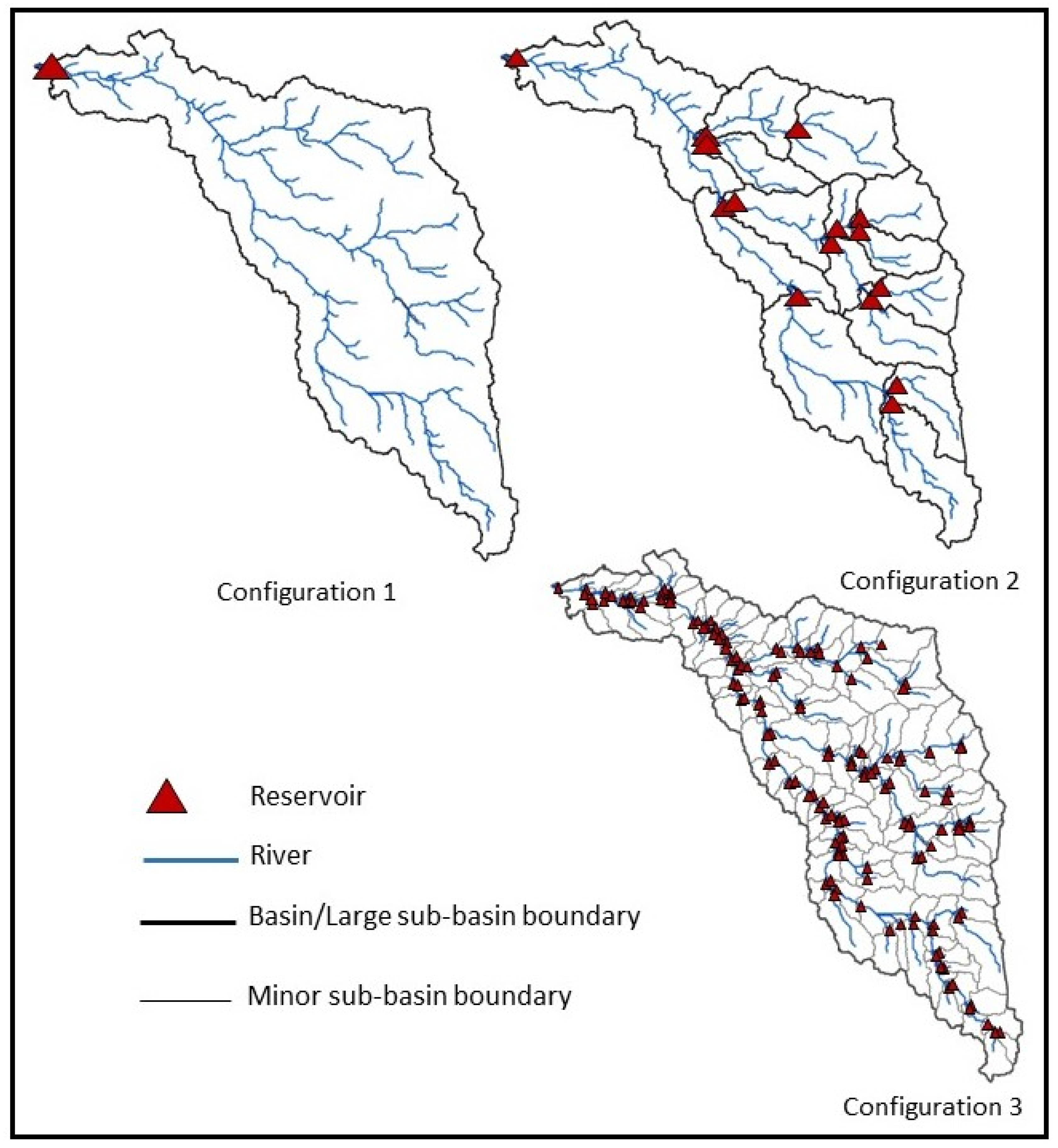
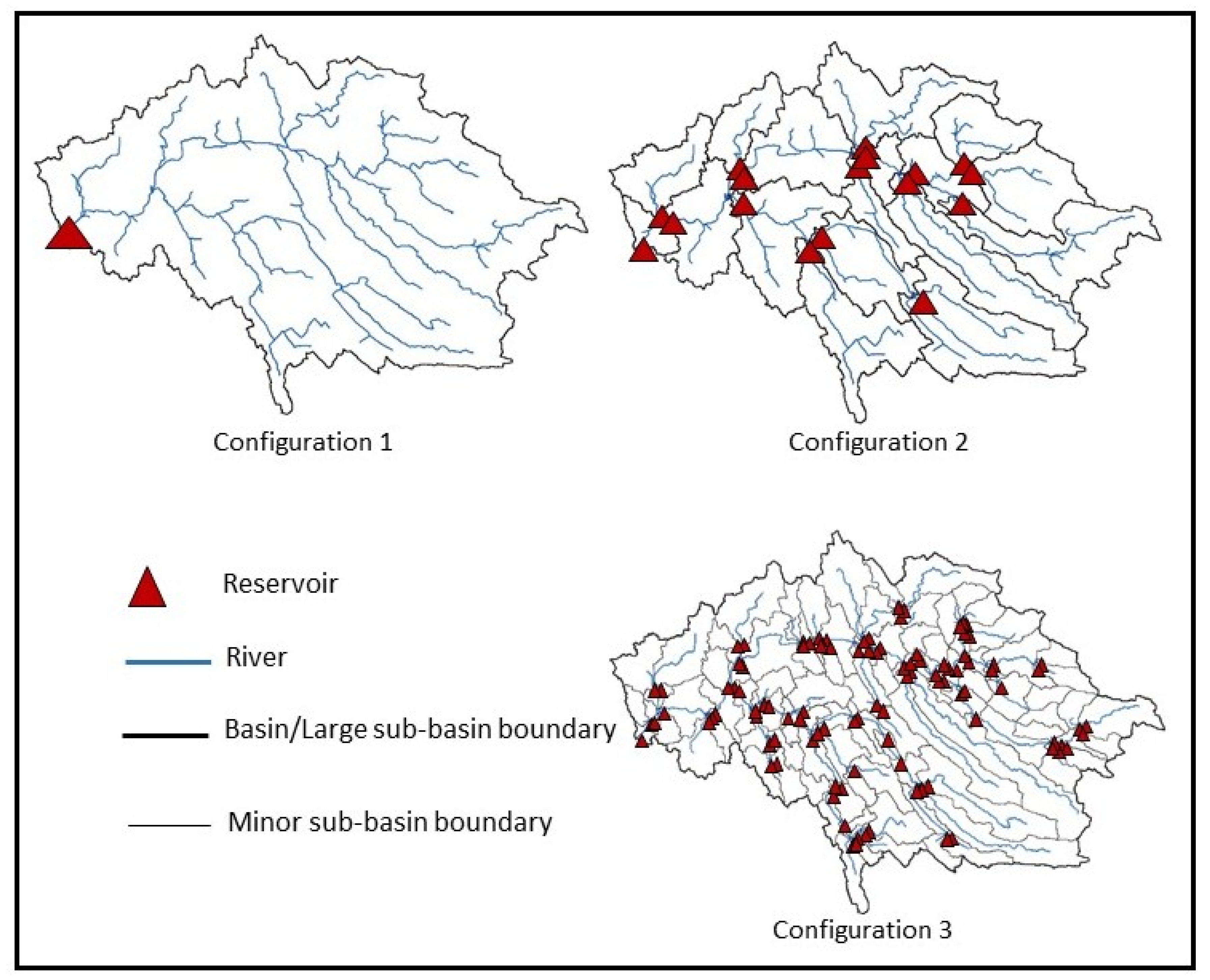
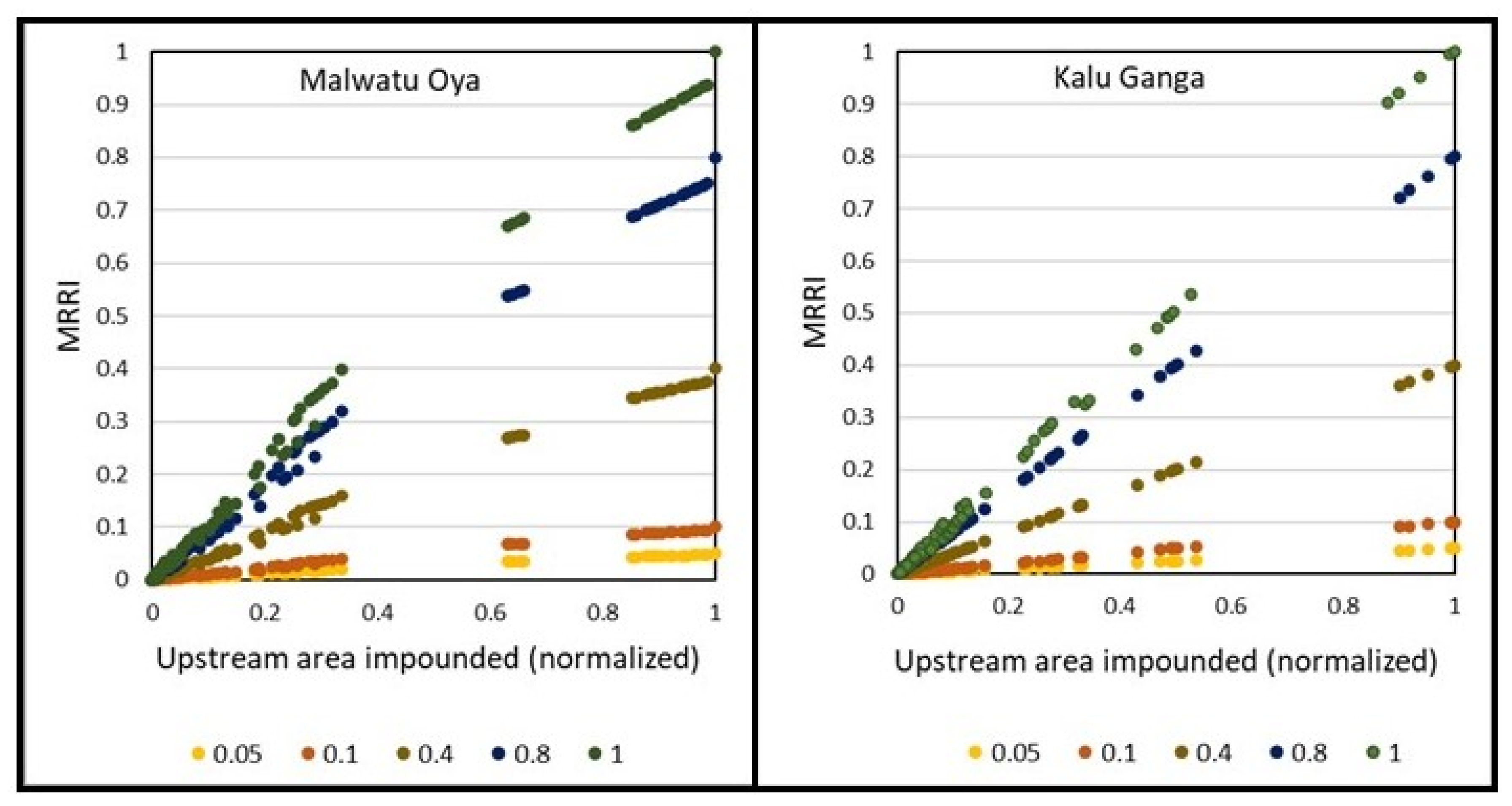



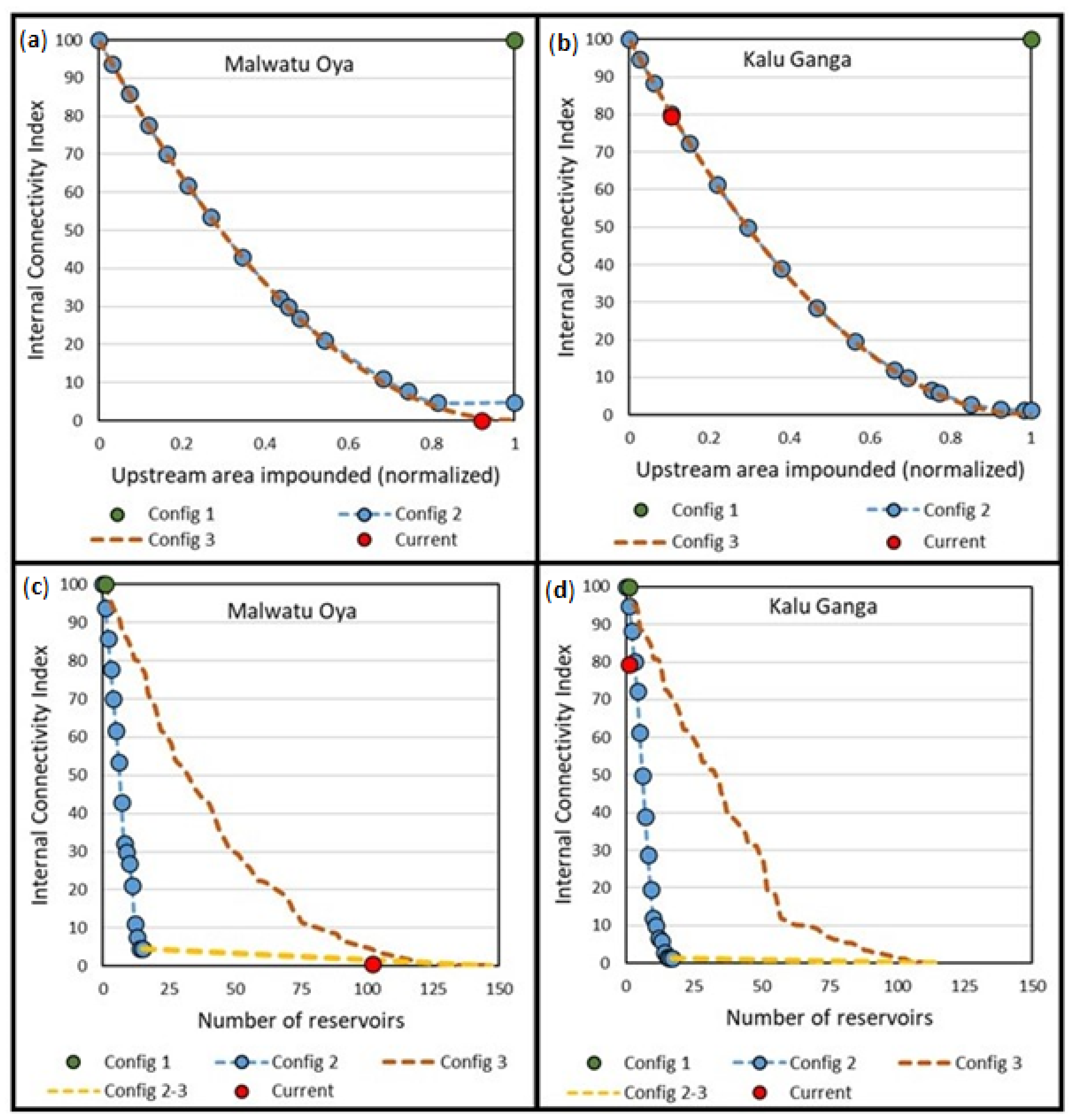

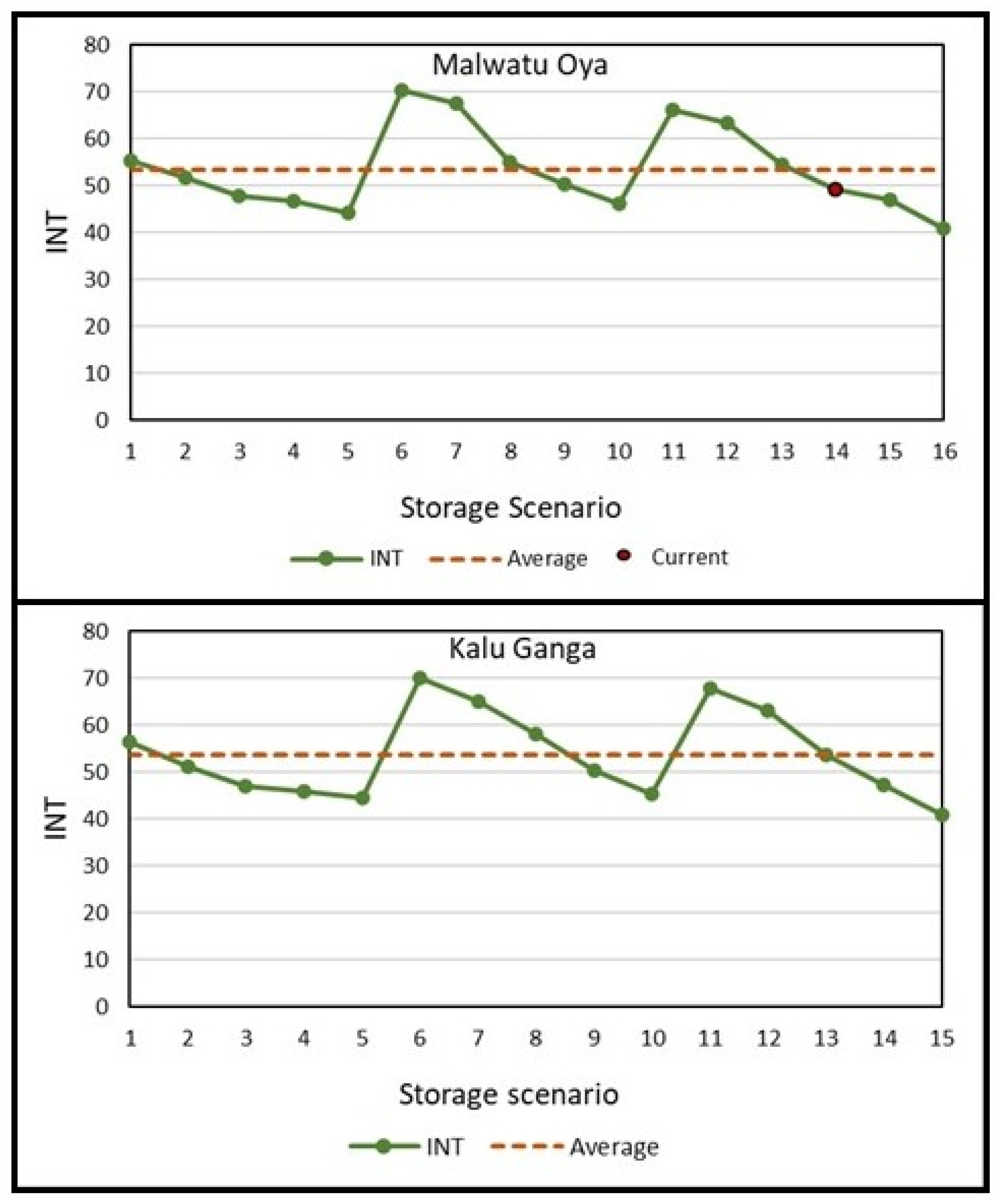
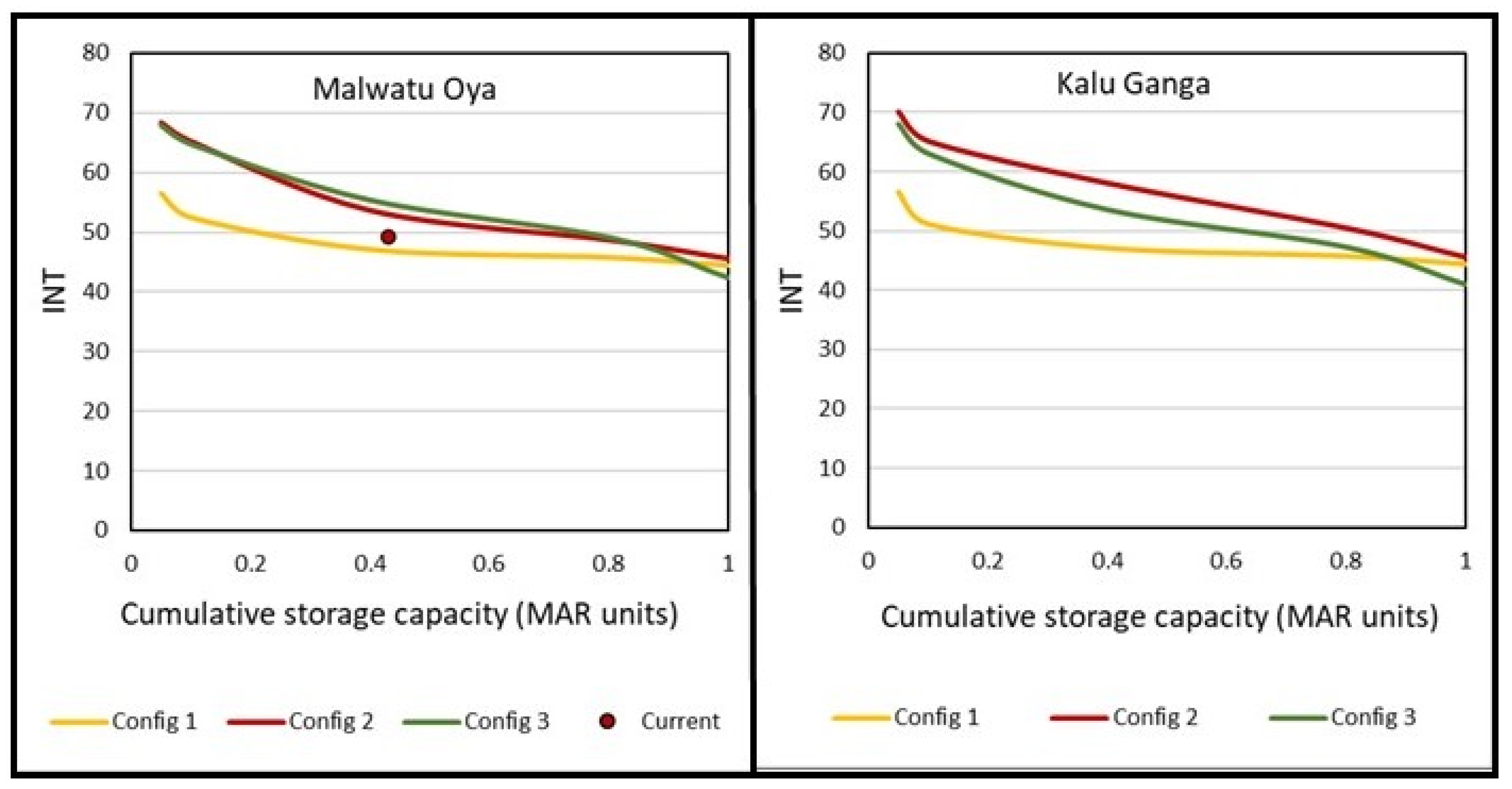

| Basin | Malwatu Oya | Kalu Ganga | ||||
|---|---|---|---|---|---|---|
| Configuration | 1 | 2 | 3 | 1 | 2 | 3 |
| Number of reservoirs | 1 | 15 | 148 | 1 | 17 | 114 |
| Average basin area draining into a single reservoir (km2) | 3338 | 223 | 22.6 | 2296 | 172 | 25.7 |
| Average MAR draining into a single reservoir (km3 year−1) | 0.79 | 0.06 | 0.006 | 8.45 | 0.51 | 0.075 |
| Indicator | Cumulative Storage Capacity Range in Basin (MAR units) | Reservoir Arrangement | Focus of Investigation |
|---|---|---|---|
| WS Yield and EF Yield | 0.05–1.0 | Reservoirs are placed at all locations in Configurations 1, 2 and 3 | The impact of varying levels of cumulative storage capacity and spatial distribution of reservoirs |
| MRRI | 0.05–1.0 | Only a single reservoir is placed in the entire basin at any given time. The location of the reservoir is changed from upstream to downstream so that it is at the outlet of each minor sub-basin of Configuration 3, starting with the first-order rivers of the most upstream sub-basin in Configuration 2. Reservoirs are progressively added one by one from upstream to downstream under Configurations 1, 2 and 3, starting with first-order rivers. | The impact of the location of reservoirs and the spatial distribution of the cumulative storage capacity of the basin |
| As above | As above | ||
| NE | 0.05–1.0 | Reservoirs are placed at all locations in Configurations 1, 2 and 3 | Differences in social impacts between centralized large and distributed small reservoirs under varying cumulative storage capacities |
| Storage Capacity (MAR Units) | WS Yield (MAR Units) | EF Yield (MAR Units) | ||||||||||
|---|---|---|---|---|---|---|---|---|---|---|---|---|
| Malwatu Oya | Kalu Ganga | Malwatu Oya | Kalu Ganga | |||||||||
| 1 | 2 | 3 | 1 | 2 | 3 | 1 | 2 | 3 | 1 | 2 | 3 | |
| 0.05 | 0.16 | 0.11 | 0.10 | 0.27 | 0.22 | 0.18 | 0.84 | 0.89 | 0.90 | 0.73 | 0.78 | 0.82 |
| 0.1 | 0.20 | 0.16 | 0.15 | 0.43 | 0.35 | 0.29 | 0.80 | 0.84 | 0.85 | 0.57 | 0.65 | 0.71 |
| 0.4 | 0.37 | 0.35 | 0.33 | 0.87 | 0.72 | 0.63 | 0.63 | 0.65 | 0.67 | 0.13 | 0.28 | 0.37 |
| 0.8 | 0.53 | 0.50 | 0.48 | 0.94 | 0.84 | 0.76 | 0.47 | 0.50 | 0.52 | 0.06 | 0.16 | 0.24 |
| 1 | 0.59 | 0.56 | 0.53 | 0.96 | 0.88 | 0.80 | 0.41 | 0.44 | 0.47 | 0.04 | 0.12 | 0.20 |
| Basin | Malwatu Oya | Kalu Ganga | ||
|---|---|---|---|---|
| Configuration | 2 | 3 | 2 | 3 |
| Number of reservoirs | 15 | 148 | 17 | 114 |
| Cumulative storage capacity in Basin (MAR units) | Overall NE Value | |||
| 0.05 | 4 | 2 | 2 | 2 |
| 0.1 | 5 | 3 | 2 | 2 |
| 0.4 | 7 | 5 | 3 | 3 |
| 0.8 | 10 | 9 | 7 | 7 |
| 1 | 12 | 12 | 9 | 9 |
| Config. | Storage Scenario | Storage Capacity (MAR Units) | Storage Capacity (Million m3) | Maximum WS Yield (Million m3 year−1) | EF Yield (Million m3 year−1) | MRRI (years) | MRCIinternal | NE | INT |
|---|---|---|---|---|---|---|---|---|---|
| Malwatu Oya | |||||||||
| 1 | 1 | 0.05 | 39.48 | 125.56 | 664.13 | 0.05 | 100 | VL | 56 |
| 2 | 0.1 | 78.97 | 159.52 | 630.18 | 0.1 | 100 | VL | 52 | |
| 3 | 0.4 | 315.88 | 294.56 | 495.14 | 0.4 | 100 | VL | 47 | |
| 4 | 0.8 | 631.76 | 420.12 | 369.58 | 0.8 | 100 | VL | 46 | |
| 5 | 1 | 789.70 | 469.08 | 320.62 | 1 | 100 | VL | 44 | |
| 2 | 6 | 0.05 | 39.48 | 88.57 | 701.13 | 0.014 | 4.669 | 4 | 68 |
| 7 | 0.1 | 78.97 | 126.47 | 663.22 | 0.028 | 4.669 | 5 | 65 | |
| 8 | 0.4 | 315.88 | 276.40 | 513.29 | 0.113 | 4.669 | 7 | 54 | |
| 9 | 0.8 | 631.76 | 397.69 | 392.00 | 0.226 | 4.669 | 10 | 49 | |
| 10 | 1 | 789.70 | 438.38 | 351.32 | 0.283 | 4.669 | 12 | 45 | |
| 3 | 11 | 0.05 | 39.48 | 78.58 | 711.12 | 0.005 | 0.100 | 3 | 68 |
| 12 | 0.1 | 78.97 | 115.56 | 674.14 | 0.009 | 0.100 | 3 | 65 | |
| 13 | 0.4 | 315.88 | 259.56 | 530.14 | 0.037 | 0.100 | 5 | 55 | |
| 14 | 0.43 | 339.57 | 244.02 | 353.49 | 0.029 | 0.482 | 6 | 49 | |
| 15 | 0.8 | 631.76 | 376.46 | 413.24 | 0.075 | 0.100 | 9 | 49 | |
| 16 | 1 | 789.70 | 418.36 | 371.34 | 0.093 | 0.100 | 12 | 42 | |
| Kalu Ganga | |||||||||
| 1 | 1 | 0.05 | 422.64 | 2240.00 | 6212.82 | 0.05 | 100 | VL | 56 |
| 2 | 0.1 | 845.28 | 3651.62 | 4801.20 | 0.1 | 100 | VL | 51 | |
| 3 | 0.4 | 3381.13 | 7311.68 | 1141.13 | 0.4 | 100 | VL | 47 | |
| 4 | 0.8 | 6762.25 | 7937.19 | 515.62 | 0.8 | 100 | VL | 46 | |
| 5 | 1 | 8452.81 | 8038.63 | 414.19 | 1 | 100 | VL | 44 | |
| 2 | 6 | 0.05 | 422.64 | 1869.66 | 6583.15 | 0.010 | 1.366 | 2 | 70 |
| 7 | 0.1 | 845.28 | 2955.88 | 5496.93 | 0.021 | 1.366 | 2 | 65 | |
| 8 | 0.4 | 3381.13 | 6103.02 | 2349.79 | 0.083 | 1.366 | 3 | 58 | |
| 9 | 0.8 | 6762.25 | 7105.63 | 1347.19 | 0.166 | 1.366 | 7 | 50 | |
| 10 | 1 | 8452.81 | 7331.09 | 1121.73 | 0.207 | 1.366 | 9 | 45 | |
| 3 | 11 | 0.05 | 422.64 | 1518.21 | 6934.60 | 0.004 | 0.064 | 2 | 68 |
| 12 | 0.1 | 845.28 | 2409.36 | 6043.46 | 0.009 | 0.064 | 2 | 63 | |
| 13 | 0.4 | 3381.13 | 5329.01 | 3123.81 | 0.036 | 0.064 | 3 | 54 | |
| 14 | 0.8 | 6762.25 | 6429.12 | 2023.70 | 0.072 | 0.064 | 7 | 47 | |
| 15 | 1 | 8452.81 | 6763.86 | 1688.96 | 0.090 | 0.064 | 9 | 41 | |
|
Alternative Integrated Index | Estimation Formula |
|---|---|
| INT1 | |
| INT2 | |
| INT3 | |
| INT4 |
Publisher’s Note: MDPI stays neutral with regard to jurisdictional claims in published maps and institutional affiliations. |
© 2022 by the authors. Licensee MDPI, Basel, Switzerland. This article is an open access article distributed under the terms and conditions of the Creative Commons Attribution (CC BY) license (https://creativecommons.org/licenses/by/4.0/).
Share and Cite
Eriyagama, N.; Smakhtin, V.; Udamulla, L. Sustainable Surface Water Storage Development: Measuring Economic Benefits and Ecological and Social Impacts of Reservoir System Configurations. Water 2022, 14, 307. https://doi.org/10.3390/w14030307
Eriyagama N, Smakhtin V, Udamulla L. Sustainable Surface Water Storage Development: Measuring Economic Benefits and Ecological and Social Impacts of Reservoir System Configurations. Water. 2022; 14(3):307. https://doi.org/10.3390/w14030307
Chicago/Turabian StyleEriyagama, Nishadi, Vladimir Smakhtin, and Lakshika Udamulla. 2022. "Sustainable Surface Water Storage Development: Measuring Economic Benefits and Ecological and Social Impacts of Reservoir System Configurations" Water 14, no. 3: 307. https://doi.org/10.3390/w14030307
APA StyleEriyagama, N., Smakhtin, V., & Udamulla, L. (2022). Sustainable Surface Water Storage Development: Measuring Economic Benefits and Ecological and Social Impacts of Reservoir System Configurations. Water, 14(3), 307. https://doi.org/10.3390/w14030307






